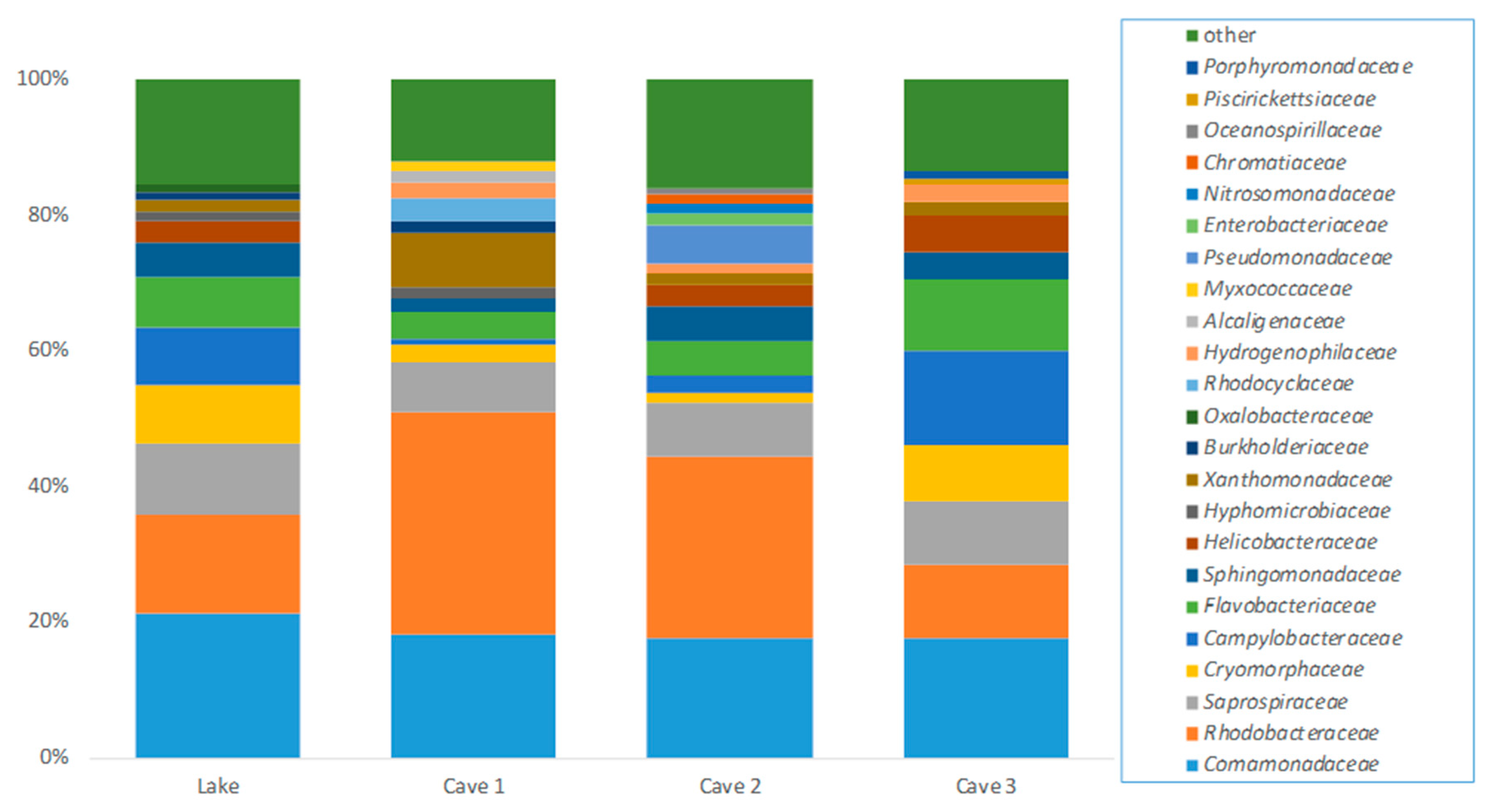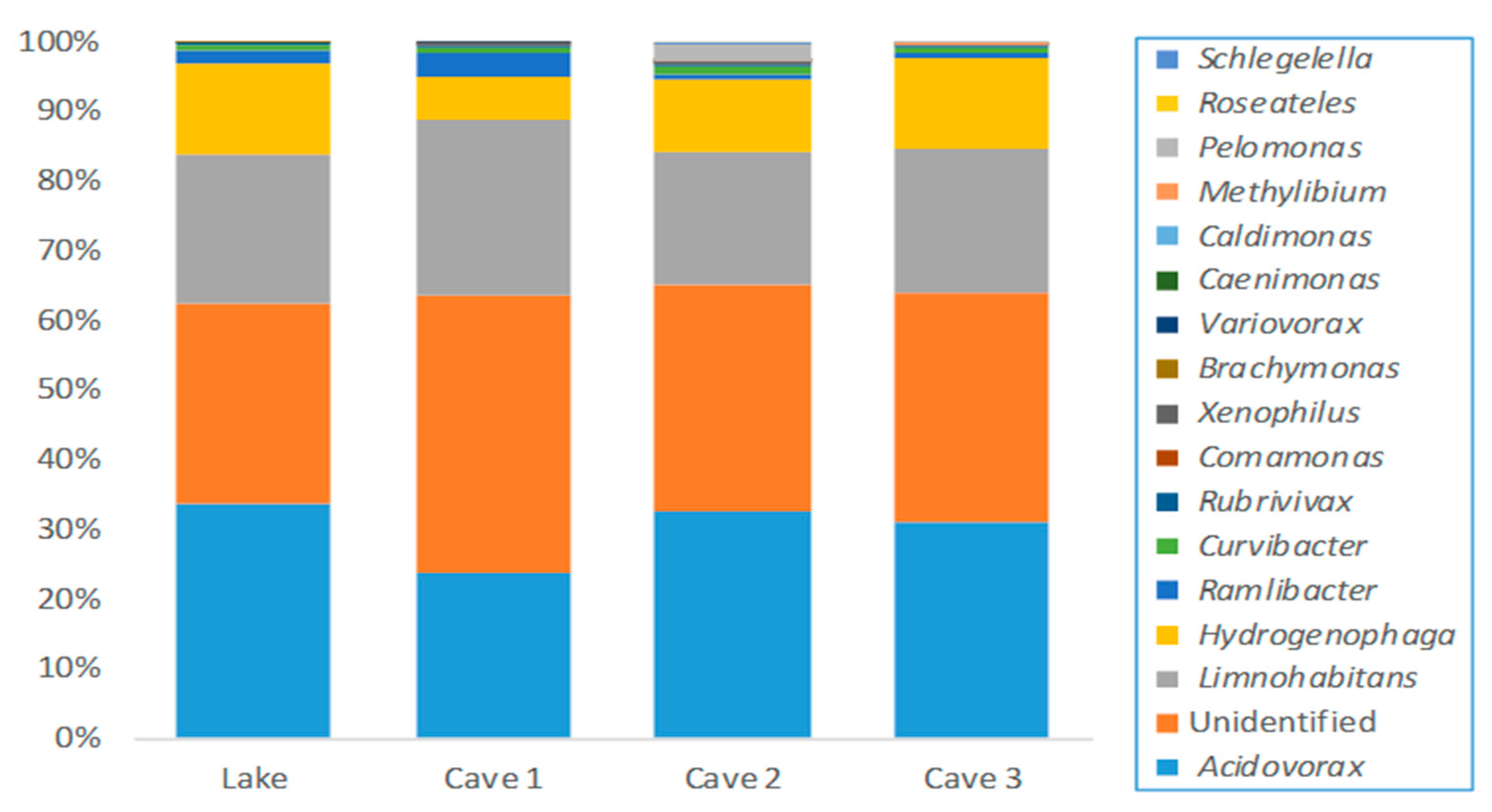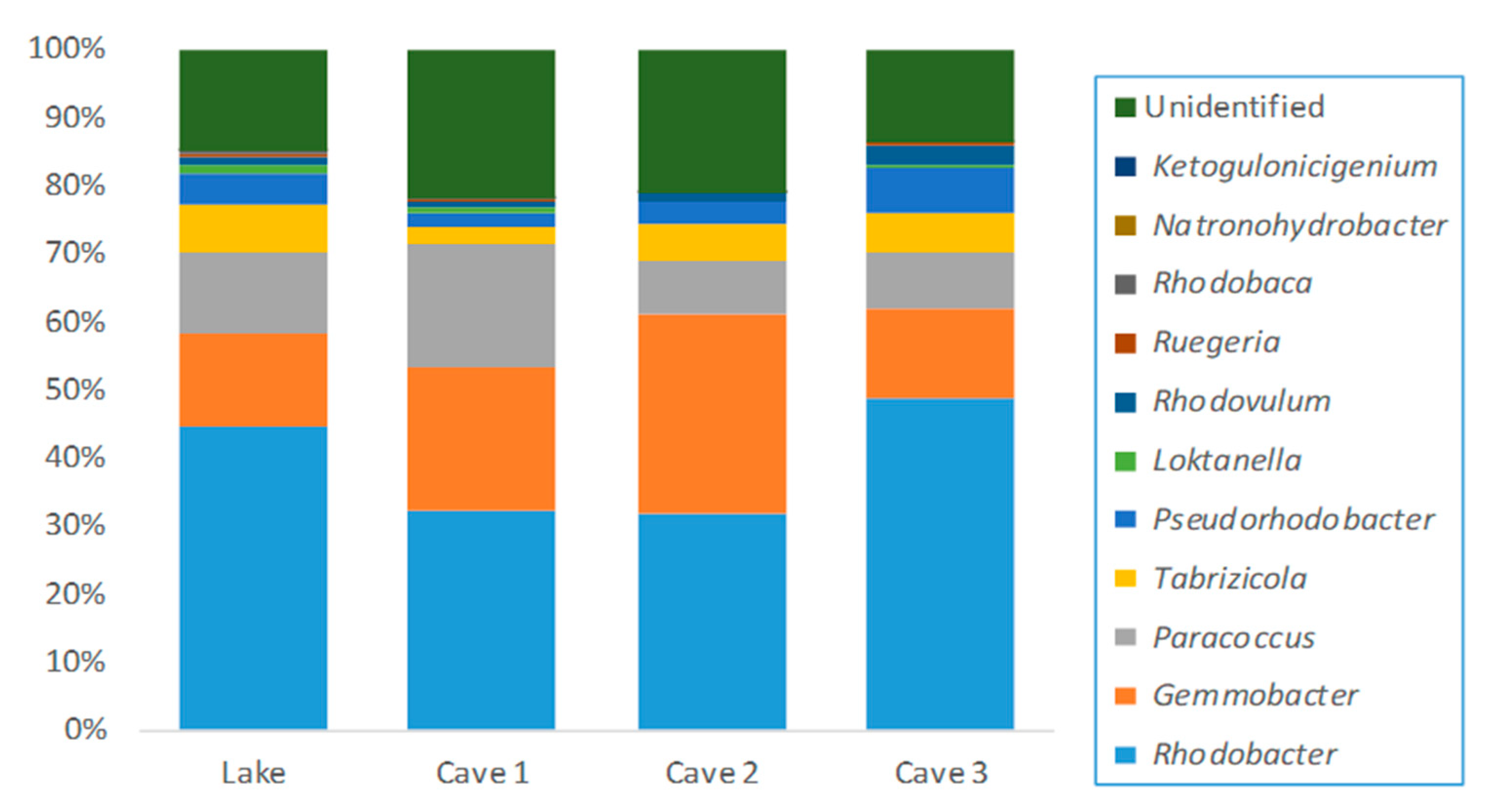Exploring the Bacterial Communities of the Kaiafas Thermal Spring Anigrides Nymphes in Greece Prior to Rehabilitation Actions
Abstract
1. Introduction
2. Materials and Methods
2.1. Water Sampling
2.2. Microbiological Analysis
2.3. Sequencing Analysis
2.4. Statistical Analysis
3. Results
4. Discussion
5. Conclusions
Supplementary Materials
Author Contributions
Funding
Conflicts of Interest
References
- Routh, H.B.; Bhowmik, K.R.; Parish, L.C.; Witkowski, J.A. Balneology, mineral water, and spas in historical perspective. Clin. Dermatol. 1996, 14, 551–554. [Google Scholar] [CrossRef]
- Matsumoto, S. Evaluation of the role of balneotherapy in rehabilitation medicine. J. Nippon Med Sch. 2018, 85, 196–203. [Google Scholar] [CrossRef]
- Parish, L.C.; Lotti, T.M. Commentary. Clin. Dermatol. 1996, 14, 547–548. [Google Scholar] [CrossRef]
- World Health Organization (WHO). Guidelines for Safe Recreational Water Environments; WHO: Geneva, Switzerland, 2006; Volume 2, Available online: http://apps.who.int/iris/bitstream/10665/43336/1/9241546808_eng.pdf (accessed on 29 May 2018).
- Insler, M.S.; Gore, H. Pseudomonas keratitis and folliculitis from Whirlpool Exposure. Am. J. Ophthalmol. 1986, 101, 41–43. [Google Scholar] [CrossRef]
- Leoni, E.; Catalani, F.; Marini, S.; Dallolio, L. Legionellosis associated with recreational waters: A systematic review of cases and outbreaks in swimming pools, spa pools, and similar environments. Int. J. Environ. Res. Public Health 2018, 15, 1612. [Google Scholar] [CrossRef] [PubMed]
- Valeriani, F.; Margarucci, L.M.; Romano Spica, V. Recreational use of spa thermal waters: Criticisms and perspectives for innovative treatments. Int. J. Environ. Res. Public Health 2018, 15, 2675. [Google Scholar] [CrossRef]
- Public Properties Company S.A. (PPCo S.A.). Available online: https://www.etad.gr/%CE%B1%CE%BE%CE%B9%CE%BF%CF%80%CE%BF%CE%AF%CE%B7%CF%83%CE%B7-%CE%B1%CE%BA%CE%B9%CE%BD%CE%AE%CF%84%CF%89%CE%BD/axiopoiisi-akiniton-touristikes-egatastaseis/ (accessed on 15 June 2020).
- Etiope, G.; Papatheodorou, G.; Christodoulou, D.P.; Ferentinos, G.; Sokos, E.; Favali, P. Methane and hydrogen sulfide seepage in the northwest Peloponnesus petroliferous basin (Greece): Origin and geohazard. Am. Assoc. Pet. Geol. Bull. 2006, 90, 701–713. [Google Scholar] [CrossRef]
- EUR-Lex. Directive 2006/7/EC of the European Parliament and of the Council of 15 February 2006 Concerning the Management of Bathing Water Quality and Repealing Directive 76/160/EEC. 2006. Available online: https://eur-lex.europa.eu/legal-content/GA/TXT/?uri=CELEX:32006L0007 (accessed on 14 December 2018).
- Venieri, D.; Vantarakis, A.; Komninou, G.; Papapetropoulou, M. Microbiological evaluation of bottled non-carbonated (“still) water from domestic brands in Greece. Int. J. Food Microbiol. 2005, 107, 68–72. [Google Scholar] [CrossRef]
- The National Printing House. Microbiological Quality of Thermal Waters. Greek Official Journal, Series B. Issue 1853 of 27 August 2015. Available online: http://www.et.gr/idocs-nph/search/pdfViewerForm.html?args=5C7QrtC22wE4q6ggiv8WTXdtvSoClrL8WtYosSaVLSi4ndCieBbLVuJInJ48_97uHrMts-zFzeyCiBSQOpYnTy36MacmUFCx2ppFvBej56Mmc8Qdb8ZfRJqZnsIAdk8Lv_e6czmhEembNmZCMxLMtWgoImcZ_bxSelyt4xuSEDktinb-lTMFMIk8pDwpY-sE (accessed on 14 December 2018).
- Spyrelli, E.; Stamatiou, A.; Tassou, C.; Nychas, G.-J.E.; Doulgeraki, A.I. Microbiological and metagenomic analysis to assess the effect of container material on the microbiota of feta cheese during ripening. Fermentation 2020, 6, 12. [Google Scholar] [CrossRef]
- Valeriani, F.; Crognale, S.; Protano, C.; Gianfranceschi, G.; Orsini, M.; Vitali, M.; Romano Spica, V. Metagenomic analysis of bacterial community in a travertine depositing hot spring. New Microbiol. 2018, 41, 126–135. [Google Scholar]
- Paduano, S.; Valeriani, F.; Romano Spica, V.; Bargellini, A.; Borella, P.; Marchesi, I. Microbial biodiversity of thermal water and mud in an Italian spa by metagenomics: A pilot study. Water Sci. Technol. Water Supply 2018, 18, 1456–1465. [Google Scholar] [CrossRef]
- Tokajian, S.; Hashwa, F. Microbiological quality and genotypic speciation of heterotrophic bacteria isolated from potable water stored in household tanks. Water Qual. Res. J. Can. 2004, 39, 64–73. [Google Scholar] [CrossRef]
- Hwang, C.; Ling, F.Q.; Andersen, G.L.; LeChevallier, M.W.; Liu, W.T. Microbial community dynamics of an urban drinking water distribution system subjected to phases of chloramination and chlorination treatments. Appl. Environ. Microbiol. 2012, 78, 7856–7865. [Google Scholar] [CrossRef] [PubMed]
- Luhrig, K.; Canback, B.; Paul, C.J.; Johansson, T.; Persson, K.M.; Radstrom, P. Bacterial community analysis of drinking water biofilms in southern Sweden. Microbes Environ. 2015, 30, 99–107. [Google Scholar] [CrossRef] [PubMed]
- Proctor, C.R.; Edwards, M.A.; Pruden, A. Microbial composition of purified waters and implications for regrowth control in municipal water systems. Environ. Sci. 2015, 1, 882–892. [Google Scholar] [CrossRef]
- Ling, F.Q.; Hwang, C.A.; LeChevallier, M.W.; Andersen, G.L.; Liu, W.T. Core-satellite populations and seasonality of water meter biofilms in a metropolitan drinking water distribution system. ISME J. 2016, 10, 582–595. [Google Scholar] [CrossRef] [PubMed]
- Shetty, A.; Barnes, R.A.; Healy, B.; Groves, P. A case of sepsis caused by Acidovorax. J. Infect. 2005, 51, 171–172. [Google Scholar] [CrossRef]
- Saha, P.; Krishnamurthi, S.; Mayilraj, S.; Prasad, G.S.; Bora, T.C.; Chakrabarti, T. Aquimonas voraii gen. nov., sp. nov., a novel gammaproteobacterium isolated from a warm spring of Assam, India. Int. J. Syst. Evol. Microbiol. 2005, 55, 1491–1495. [Google Scholar] [CrossRef]
- Mitchell, H.M.; Rocha, G.A.; Kaakoush, N.O.; O’Rourke, J.L.; Queiroz, D.M.M. The Family Helicobacteraceae. In The Prokaryotes; Rosenberg, E., DeLong, E.F., Lory, S., Stackebrandt, E., Thompson, F., Eds.; Springer: Berlin/Heidelberg, Germnay, 2014; pp. 337–392. [Google Scholar]
- Venkata Ramana, V.; Sasikala, C.; Ramana, C. Rhodobacter maris sp. nov., a phototrophic alphaproteobacterium isolated from a marine habitat of India. Int. J. Syst. Evol. Microbiol. 2008, 58, 1719–1722. [Google Scholar] [CrossRef]
- Uchino, Y.; Hamada, T.; Yokota, A. Proposal of Pseudorhodobacter ferrugineus gen. nov., comb. nov., for a non-photosynthetic marine bacterium, Agrobacterium ferrugineum, related to the genus Rhodobacter. J. Gen. Appl. Microbiol. 2002, 48, 309–319. [Google Scholar] [CrossRef]
- Kasalicky, V.; Jezbera, J.; Hahn, M.W.; Šimek, K. The diversity of the Limnohabitans genus, an important group of freshwater bacterioplankton, by characterization of 35 isolated strains. PLoS ONE 2013, 8, 9. [Google Scholar] [CrossRef] [PubMed]
- Aragno, M.; Schlegel, H.G. Mesophilic hydrogen-oxidizing (Knallgas) bacteria. In The Prokaryotes, 2nd ed.; Balows, A., Truper, H.G., Dworkin, M., Harder, W., Schleifer, K.H., Eds.; Springer: New York, NY, USA, 1992; pp. 344–384. [Google Scholar]
- Willems, A.; Gills, M. Genus Hydrogenophaga. In Bergey’s Manual of Systematic Bacteriology, 2nd ed.; Brenner, D.J., Krieg, N.R., Staley, J.T., Eds.; Springer: New York, NY, USA, 2005; pp. 710–716. [Google Scholar]
- Choi, M.H.; Yoon, S.C.; Lenz, R.W. Production of poly(3-hydroxybutyric acid-co-4-hydroxybutyric acid) and poly(4-hydroxybutyric acid) without subsequent degradation by Hydrogenophaga pseudoflava. Appl. Environ. Microbiol. 1999, 65, 1570–1577. [Google Scholar] [CrossRef] [PubMed]
- Contzen, M.; Moore, E.R.; Blumel, S.; Stolz, A.; Kampfer, P. Hydrogenophaga intermedia sp. nov., a 4-aminobenzenesulfonate degrading organism. Syst. Appl. Microbiol. 2000, 23, 487–493. [Google Scholar] [CrossRef]
- Lambo, A.J.; Patel, T.R. Isolation and characterization of a biphenyl-utilizing psychrotrophic bacterium, Hydrogenophaga taeniospiralis IA3-A, that cometabolize dichlorobiphenyls and polychlorinated biphenyl congeners in Aroclor 1221. J. Basic Microbiol. 2006, 46, 94–107. [Google Scholar] [CrossRef]
- Gamble, T.N.; Betlach, M.R.; Tiedje, J.M. Numerically dominant denitrifying bacteria from world soils. Appl. Environ. Microbiol. 1977, 33, 926–939. [Google Scholar] [CrossRef]
- Martineau, C.; Mauffrey, F.; Villemur, R. Comparative analysis of denitrifying activities of Hyphomicrobium nitrativorans, Hyphomicrobium denitrificans, and Hyphomicrobium zavarzinii. Appl. Environ. Microbiol. 2015, 81, 5003–5014. [Google Scholar] [CrossRef]
- Xie, Z.; Lin, W.; Luo, J. Comparative phenotype and genome analysis of Cellvibrio sp. PR1, a xylanolytic and agarolytic bacterium from the Pearl River. Biomed Res. Int. 2017, 2017, 6304248. [Google Scholar] [CrossRef]
- Liu, Z.; Wang, B.; Liu, Y.; Liu, S. Novosphingobium taihuense sp. nov., a novel aromatic-compound-degrading bacterium isolated from Taihu Lake, China. Int. J. Syst. Evol. Microbiol. 2005, 55, 1229–1232. [Google Scholar] [CrossRef]
- Boden, R. 115 years of sulfur microbiology. FEMS Microbiol. Lett. 2017, 364, 6fnx043. [Google Scholar] [CrossRef][Green Version]
- McIlroy, S.J.; Nielsen, P.H. The Family Saprospiraceae. In The Prokaryotes; Rosenberg, E., DeLong, E.F., Lory, S., Stackebrandt, E., Thompson, F., Eds.; Springer: Berlin/Heidelberg, Germany, 2014. [Google Scholar]
- Bruce, R.A.; Achenbach, L.A.; Coates, J.D. Reduction of (per) chlorate by a novel organism isolated from paper mill waste. Environ. Microbiol. 2001, 1, 319–329. [Google Scholar] [CrossRef]
- Frenzel, S.A.; Couvillion, C.S. Faecal-indicator bacteria in streams along a gradient of residential development. J. Am. Water Res. Assoc. 2002, 38, 265–273. [Google Scholar] [CrossRef]
- Niemi, R.M.; Niemi, J.S. Bacterial pollution of waters in pristine and agricultural lands. J. Environ. Qual. 1991, 20, 620–627. [Google Scholar] [CrossRef]
- Tekere, M.; Lötter, A.; Olivier, J.; Jonker, N.; Venter, S. Metagenomic analysis of bacterial diversity of Siloam hot water spring, Limpopo, South Africa. Afr. J. Biotechnol. 2011, 10, 18005–18012. [Google Scholar] [CrossRef]
- Fisher, K.; Phillips, C. The ecology, epidemiology and virulence of Enterococcus. Microbiology 2009, 155, 1749–1757. [Google Scholar] [CrossRef] [PubMed]
- Ertas, N.; Dogruer, Y.; Gonulalan, Z.; Guner, A.; Ulger, I. Prevalence of Arcobacter species in drinking water, spring water, and raw milk as determined by multiplex PCR. J. Food Prot. 2010, 73, 2099–2102. [Google Scholar] [CrossRef] [PubMed]
- Meziti, A.; Nikouli, E.; Hatt, J.K.; Konstantinidis, K.; Kormas, K.A. Time series metagenomic sampling of the Thermopyles, Greece, geothermal springs reveals stable microbial communities dominated by novel sulfur-oxidizing chemoautotrophs. bioRxiv 2020, 2020, 211532. [Google Scholar] [CrossRef]
- Collado, L.; Inza, I.; Guarro, J.; Figueras, M.J. Presence of Arcobacter spp. in environmental waters correlates with high levels of fecal pollution. Environ. Microbiol. 2008, 10, 1635–1640. [Google Scholar] [CrossRef]
- Maugeri, T.L.; Carbone, M.; Fera, M.T.; Irrera, G.P.; Gugliandolo, C. Distribution of potentially pathogenic bacteria as free living and plankton associated in a marine coastal zone. J. Appl. Microbiol. 2004, 97, 354–361. [Google Scholar] [CrossRef]
- Moreno, Y.; Botella, S.; Alonso, J.L.; Ferru’s, M.A.; Hernandez, M.; Hernandez, J. Specific detection of Arcobacter and Campylobacter strains in water and sewage by PCR and fluorescent in situ hybridization. Appl. Environ. Microbiol. 2003, 69, 1181–1186. [Google Scholar] [CrossRef]
- Morita, Y.; Maruyama, S.; Kabeya, H.; Boonmar, S.; Nimsuphan, B.; Kozawa, K.; Nakajima, T.; Mikami, T.; Kimura, H. Isolation and phylogenetic analysis of Arcobacter spp. in ground chicken meat and environmental water in Japan and Thailand. Microbiol. Immunol. 2004, 48, 527–533. [Google Scholar] [CrossRef]
- Rice, E.W.; Rodgers, M.R.; Wesley, I.V.; Johnson, C.H.; Tanner, S.A. Isolation of Arcobacter butzleri from ground water. Lett. Appl. Microbiol. 1999, 28, 31–35. [Google Scholar] [CrossRef] [PubMed]
- Kiehlbauch, J.A.; Brenner, D.J.; Nicholson, M.A.; Baker, C.N.; Patton, C.M.; Steigerwalt, A.G.; Wachsmuth, I.K. Campylobacter butzleri sp. nov. isolated from humans and animals with diarrheal illness. J. Clin. Microbiol. 1991, 29, 376–385. [Google Scholar] [CrossRef] [PubMed]
- Lerner, J.; Brumberger, V.; Preac-Mursic, V. Severe diarrhea associated with Arcobacter butzleri. Eur. J. Clin. Microbiol. 1994, 13, 660–662. [Google Scholar] [CrossRef] [PubMed]
- Kormas, K.A.; Tamaki, H.; Hanada, S.; Kamagata, Y. Apparent richness and community composition of Bacteria and Archaea in geothermal springs. Aquat. Microb. Ecol. 2009, 57, 113–122. [Google Scholar] [CrossRef]
- Taylor, E.V.; Herman, K.M.; Ailes, E.C.; Fitzgerald, C.; Yoder, J.S.; Mahon, B.E.; Tauxe, R.V. Common source outbreaks of Campylobacter infection in the USA, 1997–2008. Epidemiol. Infect. 2013, 141, 987–996. [Google Scholar] [CrossRef]
- Samannodi, M.; Zhao, A.; Nemshah, Y.; Shiley, K. Plesiomonas shigelloides septic shock leading to death of postsplenectomy patient with pyruvate kinase deficiency and hemochromatosis. Case Rep. Infect. Dis. 2016, 2016, 1538501. [Google Scholar] [CrossRef] [PubMed]
- Haruna, E.S.; Usman, M.; Ahmed, S.; Shaibu, J.S.; Makinde, A.A.; Lombin, L.H.; Henton, M.M. Isolation of Citrobacter murliniae from clinically ill and dead quail, ducks and chickens. Vet. Rec. 2004, 154, 119–120. [Google Scholar] [CrossRef]
- Samonis, G.; Vouloumanou, E.K.; Christofaki, M.; Dimopoulou, D.; Maraki, S.; Triantafyllou, E.; Kofteridis, D.P.; Falagas, M.E. Serratia infections in a general hospital: Characteristics and outcomes. Eur. J. Clin. Microbiol. Infect. Dis. 2011, 30, 653–660. [Google Scholar] [CrossRef]
- Elahian, F.; Moghimi, B.; Dinmohammadi, F.; Ghamghami, M.; Hamidi, M.; Mirzaei, S.A. The anticancer agent prodigiosin is not a multidrug resistance protein substrate. DNA Cell Biol. 2013, 32, 90–97. [Google Scholar] [CrossRef]
- Hogan, C.M. Bacteria. In Encyclopedia of Earth; Draggan, S., Cleveland, C.J., Eds.; National Council for Science and the Environment: Washington, DC, USA, 2010. [Google Scholar]
- Keren, Y.; Keshet, D.; Eidelman, M.; Geffen, Y.; Raz-Pasteur, A.; Hussein, K. Is Leclercia adecarboxylata a new and unfamiliar marine pathogen? J. Clin. Microbiol. 2014, 52, 1775–1776. [Google Scholar] [CrossRef]
- Bornstein, N.; Marmet, D.; Surgot, M.; Nowicki, M.; Arslan, A.; Esteve, J.; Fleurette, J. Exposure to Legionellaceae at a hot spring spa: A prospective clinical and serological study. Epidemiol. Infect. 1989, 102, 31–36. [Google Scholar] [CrossRef] [PubMed]
- Martinelli, F.; Carasi, S.; Scarcella, C.; Speziani, F. Detection of Legionella pneumophila at thermal spas. New Microbiol. 2001, 24, 259–264. [Google Scholar] [PubMed]
- Hall, J.; Hodgson, G.; Kerr, K.G. Provision of safe potable water for immunocompromised patients in hospital. J. Hosp. Infect. 2004, 58, 155–158. [Google Scholar] [CrossRef] [PubMed]
- Trautmann, M.; Halder, S.; Hoegel, J.; Royer, H.; Haller, M. Point of use filtration reduces endemic Pseudomonas aeruginosa infections on a surgical intensive care unit. Am. J. Infect. Control 2008, 36, 421–429. [Google Scholar] [CrossRef] [PubMed]
- Price, D.; Ahearn, D.G. Incidence and persistence of Pseudomonas aeruginosa in whirlpools. J. Clin. Microbiol. 1988, 26, 1650–1654. [Google Scholar] [CrossRef] [PubMed]
- Dadswell, J. Poor swimming pool management: How real is the health risk? Environ. Health 1997, 105, 69–73. [Google Scholar]
- Ratnam, S.; Hogan, K.; March, S.B.; Butler, R.W. Whirlpool-associated folliculitis caused by Pseudomonas aeruginosa: Report of an outbreak and review. J. Clin. Microbiol. 1986, 23, 655–659. [Google Scholar] [CrossRef]
- Bruhn, L.; Wolfson, L. Bacteria and water quality. In Citizens Monitoring Bacteria: A Training Manual for Monitoring E. coli, 2nd ed.; Crighton, L., Herbert, J., Iles, J., Liukkonen, B., O’Brian, E., Stepenuck, K., Eds.; Michigan State University: East Lansing, MI, USA, 2007; pp. 7–10. [Google Scholar]
- Kistemann, T.; Classen, T.; Koch, C.; Dangendorf, F.; Fischeder, R.; Gebel, J.; Vacata, V.; Exner, M. Microbial load of drinking water reservoir tributaries during extreme rainfall and runoff. Appl. Environ. Microbiol. 2002, 68, 2188–2197. [Google Scholar] [CrossRef]
- Parker, J.L.; Shaw, J.G. Aeromonas spp. clinical microbiology and disease. J. Infect. 2011, 62, 109–118. [Google Scholar] [CrossRef]
- Collins, C.H.; Grange, J.M.; Yates, M.D. A review. Mycobacterium in water. J. Appl. Bacteriol. 1984, 57, 193–211. [Google Scholar] [CrossRef]
- Embil, J.; Warren, P.; Yakrus, M.; Corne, S.; Forrest, D.; Hershfield, E. Pulmonary illness associated with exposure to Mycobacterium avium complex in hot tub water. CHEST 1997, 111, 534–536. [Google Scholar] [CrossRef] [PubMed]
- Engelbrecht, R.S.; Severnin, B.F.; Massarik, M.T.; Faroo, S.; Lee, S.H.; Haas, C.N.; Lalchandani, A. New Microbial Indicators of Disinfection Efficiency; Report No. EPA 600/2-77-052; United States Environmental Protection Agency: Washington, DC, USA, 1977. [Google Scholar]



| Microbiological Parameter | Population (CFU/100mL Water) | ||||
|---|---|---|---|---|---|
| Sampling Point | Thermal Water Parameter’s Value [10,12] | ||||
| Lake | Cave 1 | Cave 2 | Cave 3 | ||
| Mean Value 1 [Lowest–Highest] 2 | Mean Value [Lowest–Highest] | Mean Value [Lowest–Highest] | Mean Value [Lowest–Highest] | ||
| Total viable counts (22 °C) | 253,333 [170,000–440,000] | 185,000 [140,000–230,000] | 5,630,000 [1,490,000–11,000,000] | 1,000,000 [420,000–2,100,000] | <200 |
| Total viable counts (37 °C) | 360,000 [160,000–640,000] | 250,000 [160,000–340,000] | 5,810,000 [830,000–12,100,000] | 916,667 [360,000–1,980,000] | <200 |
| Escherichia coli | 95 [75–106] | 71 [66–75] | 495 [376–720] | 300 [142–536] | 0 |
| Coliforms | 10,833 [9400–11,600] | 6050 [5400–6700] | 274,667 [28,000–760,000] | 42,900 [11,700–95,000] | <15 |
| Enterococcus | 3000 [1000–7000] | 2044 [1088–3000] | 45,333 [7000–113,000] | 26,000 [5000–40,000] | <0 (value for drinking water) |
| Pseudomonas aeruginosa | 108 [60–170] | 61 [51–71] | 153 [99–195] | 122 [116–132] | <10 |
| Legionella (presumptive colonies) 3 | 7069 [5689–8448] | 3368 [2037–4704] | 3532 [2224–4840] | 3200 [2384–4016] | <1 |
Publisher’s Note: MDPI stays neutral with regard to jurisdictional claims in published maps and institutional affiliations. |
© 2020 by the authors. Licensee MDPI, Basel, Switzerland. This article is an open access article distributed under the terms and conditions of the Creative Commons Attribution (CC BY) license (http://creativecommons.org/licenses/by/4.0/).
Share and Cite
Doulgeraki, A.I.; Bikouli, V.; Argyri, A.A.; Chorianopoulos, N.; Mitre, E.; Charvourou, G.; Sourri, P.; Tassou, C.C.; Oikonomou, A. Exploring the Bacterial Communities of the Kaiafas Thermal Spring Anigrides Nymphes in Greece Prior to Rehabilitation Actions. Int. J. Environ. Res. Public Health 2020, 17, 9133. https://doi.org/10.3390/ijerph17239133
Doulgeraki AI, Bikouli V, Argyri AA, Chorianopoulos N, Mitre E, Charvourou G, Sourri P, Tassou CC, Oikonomou A. Exploring the Bacterial Communities of the Kaiafas Thermal Spring Anigrides Nymphes in Greece Prior to Rehabilitation Actions. International Journal of Environmental Research and Public Health. 2020; 17(23):9133. https://doi.org/10.3390/ijerph17239133
Chicago/Turabian StyleDoulgeraki, Agapi I., Vasiliki Bikouli, Anthoula A. Argyri, Nikos Chorianopoulos, Elisavet Mitre, Georgia Charvourou, Patra Sourri, Chrysoula C. Tassou, and Alexandra Oikonomou. 2020. "Exploring the Bacterial Communities of the Kaiafas Thermal Spring Anigrides Nymphes in Greece Prior to Rehabilitation Actions" International Journal of Environmental Research and Public Health 17, no. 23: 9133. https://doi.org/10.3390/ijerph17239133
APA StyleDoulgeraki, A. I., Bikouli, V., Argyri, A. A., Chorianopoulos, N., Mitre, E., Charvourou, G., Sourri, P., Tassou, C. C., & Oikonomou, A. (2020). Exploring the Bacterial Communities of the Kaiafas Thermal Spring Anigrides Nymphes in Greece Prior to Rehabilitation Actions. International Journal of Environmental Research and Public Health, 17(23), 9133. https://doi.org/10.3390/ijerph17239133








